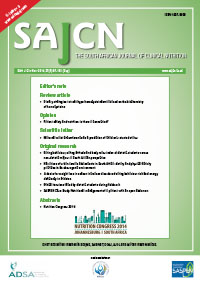Dietary strategies to treat hyperhomocysteinaemia based on the biochemistry of homocysteine: a review
Keywords:
alcohol, B vitamins, coffee, homocysteine, lipotropics, tea
Abstract
Hyperhomocysteinaemia is implicated in various diseases, including cardiovascular disease and cancer. Several conditions influence the concentration of homocysteine (Hcy), including demographic, genetic and lifestyle factors. With regard to the latter, dietary components may be manipulated as Hcy can be remethylated to methionine by folate, or metabolised by other one-carbon nutrients, such as betaine and its precursor, choline. This metabolic interplay enables the nutritionist or dietitian to be able to lower Hcy concentrations cost-effectively by tailoring an individual’s diet, or by food enrichment and fortification strategies. Evidence supports the safety and benefits of Hcy reduction by simple dietary intervention. B vitamins, and betaine and choline intake lower Hcy, whereas methionine and certain beverages (coffee, tea and alcohol) increase it. Therefore, dietary determinants of Hcy raise the prospect of a simple, inexpensive and safe means of treating and/or preventing diseases contingent on this sulphur-containing protein.
Published
2014-04-12
How to Cite
Nienaber-Rousseau, C. (2014). Dietary strategies to treat hyperhomocysteinaemia based on the biochemistry of homocysteine: a review. South African Journal of Clinical Nutrition, 27(3), 93-100. Retrieved from http://sajcn.redbricklibrary.com/index.php/SAJCN/article/view/848
Issue
Section
Review Articles
Material submitted for publication in the South African Journal of Clinical Nutrition (SAJCN) is accepted provided it has not been published elsewhere. Copyright forms will be sent with acknowledgement of receipt and the SAJCN reserves copyright of the material published.
The SAJCN does not hold itself responsible for statements made by the authors.


